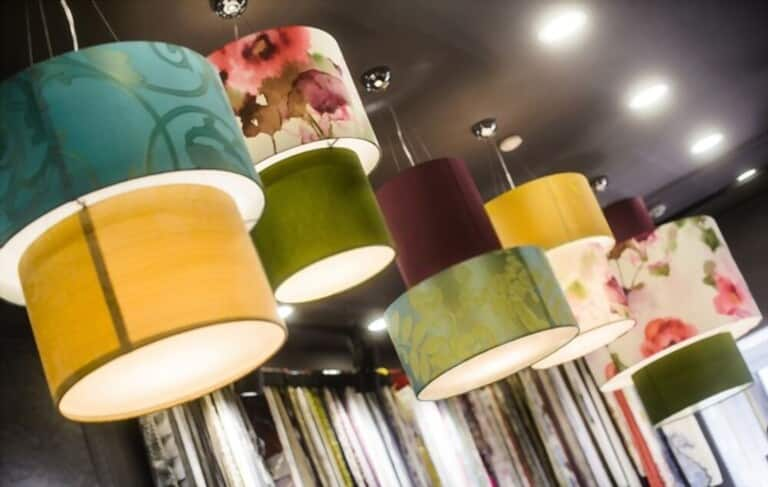One of the most durable household products is the lamp. They become instant family heirlooms because they are simple to fix or rewire. You probably have one or more lamps that were passed down through the generations towards you or that you purchased at an antique shop. Lamps may last a lifetime, but their shades do not. Shades may age, deteriorate, or simply become outdated over time. Whatever the cause, the true challenge is knowing how to choose a substitute.
How to choose lampshade size is the most crucial question you should ask yourself while selecting a lampshade. When purchasing a new lamp shade, there are a number of things to consider because form, size, and design may all have a significant impact on how well your new lampshade matches your current lamp base or lighting fixture.

Whenever you start thinking about the pattern and the color, taking some easy measurements is a great method to determine what size downlight will work best. Choosing a new color will be considerably simpler as a result.
How To Choose Lampshade Size
Sizing should be the primary consideration while picking the ideal lampshade. In our opinion, choosing the appropriate lampshade size is similar to choosing the perfect ball cap, if it's too big or little, it could appear a little odd. Similar to this, you should size the lampshade according to the lamp's base.
But once the ratios are correct, the result is harmonic and oddly pleasurable. Below, we've provided a little extra information regarding selecting the appropriate lampshade size.

Measure the lamp to determine the size of the shade.

It's time to get a measuring tape now since you're aware of the shape of your lamp base. Here are indeed our recommendations for taking a lamp's measurements for a shade.
- Approximately two-thirds of the diameter of the lamp base must be taken up by your shade.
- The key is proportionality; if your lamp becomes too tall, the effect will indeed be top-heavy, and if it is too short, it will appear unbalanced.
- You don't ever want your instrument to show, just like a slip. This is crucial if your lamp hangs over a mantle or is located near the eye.
Measure the width of the lamp bottom and multiplied by two to select the appropriate lamp shade size. Measure straight across for a round base and horizontally for a rectangular shape. Your shade's broadest point should be a little half an inch border on every side than the thickest point of your base.
And don't forget about placement when you're thinking about breadth. Therefore, choose a smaller shade if your lamp will be placed near to a bedroom or in a crowded corridor to prevent flying elbows.
Best lampshade size for table lamp

We advise the following for smaller lamps, such as table lamps:
- The shade's height must be roughly 75 percent of the base's elevation; for instance, the beautiful Aladdin is 30 cm (12 in) high, thus the shade you select should be 22.5 cm (9 inches).
- The lamp's height, measured from the base towards the fitting, should approximately match the breadth of the shade base.
- To maintain the lamp looking proportionate, the shade should preferably now be at least one centimeter (half an inch) larger than the foundation on all sides.
The bigger lampshade should generally be chosen if you're torn between two sizes. However, a modest lampshade might be more appropriate for a higher, slimmer lamp that you've selected.
Floor lamps, on the other hand, typically accept shades with a diameter of 45cm (18 feets) or greater. Finding the ideal lampshade for your decor will be made much easier if you know how to evaluate a lampshade.
Determine best lampshade size for ceiling lamp

How big of a lamp shade do ceiling lights require? The drop height, the total size of the space, and the location at which ceiling light will indeed be hung will be the most crucial things to take into account while looking for a ceiling lighting fixture.
The fall length of the illumination must be left underneath—is the most important consideration for a ceiling shade. Calculate the decline height for your replacement lamp shade out from fitter by taking the measurement from the light connection (in which the bulb will really be). In order for people to comfortably pass below the area wherever your ceiling shade was hung, it is recommended that you leave a sufficient clearance from the bottom of the chandelier to the floor (about 7 or 8 feet).
Consider the overall length of the table when hanging a shade beyond a desk or dining table. A huge light fixture that is approximately one-third to twothirds the width of a tabletop would be the ideal complement to a sizable dining table. Consider proportions when choosing a shade for a smaller table and make sure the size gap in between light and tables isn't too great.
Coordinating its shade's size with the environment

Additionally, pay close attention to the area where the lampshade will indeed be positioned.
For instance, a huge, mostly empty room may sustain a floor lamp shade that is much larger than it can in a smaller area. A little lampshade may appear out of place in a vast space, especially if it is the only one present. A larger lampshade should also provide more effective lighting.
If you're looking for a table lamp, you should think about the height of the tables and the furniture you want to set around it. Our various lampshade fittings are suitable for a variety of settings, but if you're unsure, we'll be pleased to assist.
How to choose the appropriate lampshade size
Do you need some assistance choosing a suitable lampshade? We have compiled a few guidelines to assist with your inquiries, including one we frequently hear. "How is a lamp shade measured?"
1. Measure the lamp shade's TOP across.
There are many sizes and shapes for fabric shades. The lamp shade's shape should be selected with consideration for the lamp base's shape. Also take into account where the lamp will be placed, as some shapes enable the light to be placed in the vicinity to the walls or other pieces of furniture.
2. Measure the lamp shade's width across the BOTTOM.
Measuring the height of a lamp first from the bottom edge of such a base to the peak of the bulb stem is the most accurate technique to estimate the bottom size of something like the shade for the table lamp.
The bottom diameter of the lamp shade you select should be within 2", plus or minus, of the lamp's measured height. For instance, if your lamp is 14" tall (as determined by the above-mentioned method), the shade you choose ought to have a bottom size of 12", 13", 14", 15", or 16" depending on your taste for a small, moderate, or large-looking shade. Our fabric light specifications will specify each shade's bottom size.
3. Measure the lamp shade's SLANT (side).
The harp's height is precisely proportional to that same shade's total height. As a general guideline, the shade's total height shouldn't be narrower than the harp's height less than 1/ 2" or larger than with the harp's height plus 1/ 2".
Because you want to adequately cover the bulb without concealing the lamp base, the lampshade height is crucial.
The majority of lamp coverings will list these three dimensions (Top Bottom Slant). The height, measured from top to bottom, is a third dimension that is useful. Some of the following "rules of thumb" can be aided by this.
Conclusion
Overall, the diameter across the bottom of a lampshade determines its size, thus if it says its size is 14 inches, it refers to the width throughout bottom (instead of around the shade - this will be the curvature). We sincerely hope that our advice on how to select a lampshade's size has indeed been useful in helping you select the ideal shade for your lampshade or space.













